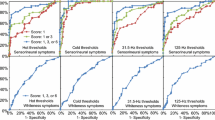Summary
To evaluate the usefulness of aesthesiometric threshold testing in the quantitative assessment of peripheral sensorineural disorders occurring in the hand-arm vibration syndrome, two point discrimination (TPD) and depth sense perception (DSP) thresholds were measured by means of two aesthesiometers in the fingertips of 65 forestry workers exposed to chain saw vibration and 91 healthy males unexposed to local vibration or neurotoxic chemicals. Among the healthy subjects, divided into three age groups, there was no difference in the mean values of TPD and DSP thresholds. Assuming 1.28 or 2 standard deviations above the mean to be the upper limits of normality, in the present study the threshold values for TPD were 2.5 and 3.13 mm, respectively. Using the same assumptions, the normal threshold values for DSP were 0.36 and 0.49 mm. Among the 65 chain saw operators the prevalence of peripheral sensory disturbances was 70.8%. On the basis of the aesthesiometric results obtained for the group of 46 chain sawyers affected with sensorineural symptoms and a control group of 46 manual workers, the specificity of the aesthesiometric testing method was found to range between 93.4 and 100%, while the sensitivity varied from 52.2 to 71.7%. In its predictive value aesthesiometry had a positive accuracy of 84.6–96.0% and a negative accuracy of 42.8–50.0%. Aesthesiometric testing was able to differentiate between normals and vibration workers with sensory disturbances on a group basis (P < 0.001), but due to the high rate of false negatives among vibration exposed patients, it was unsuitable to confirm objectively sensorineural symptoms on an individual basis. We conclude that aesthesiometry may be used in field surveys for epidemiological purposes to assess peripheral sensory disorders in exposed groups at risk.
Similar content being viewed by others
References
Bleecker ML (1986) Vibration perception thresholds in entrapment and toxic neuropathies. J Occup Med 28:991–994
Brammer AJ, Taylor W, Piercy JE (1986) Assessing the severity of the neurological component of the hand-arm vibration syndrome. Scand J Work Environ Health 12:427–431
Brammer AJ, Taylor W, Lundborg G (1987) Sensorineural stages of the hand-arm vibration syndrome. Scand J Work Environ Health 13:279–283
Carlson W, Samueloff S, Taylor W, Wasserman D (1979) Instrumentation of measurement of sensory loss in the fingertips. J Occup Med 21:260–264
Carlson W, Smith R, Taylor W (1984) Vibration syndrome in chipping and grinding workers: V. A. Aesthesiometry. J Occup Med 26:776–780
Chatterjee DS, Petrie A, Taylor W (1978) Prevalence of vibration-induced white finger in fluorspar mines in Weardale. Br J Ind Med 35:208–218
Haines T, Chong JP (1987) Peripheral neurological assessment methods for workers exposed to hand-arm vibration. An appraisal. Scand J Work Environ Health 13:370–374
Haines T, Chong J, Verrall AB, Julian J, Bernholz C, Spears R, Muir DCF (1988) Aesthesiometric threshold changes over the course of a workshift in miners exposed to hand-arm vibration. Br J Ind Med 45:106–111
Pelmear PL, Taylor W, Pearson JCG (1975) Clinical objective tests for vibration white finger. In: Taylor W, Pelmear PL (eds) Vibration white finger in industry. Academic Press, New York, pp 53–81
Renfrew S (1969) Fingertip sensation: a routine neurological test. Lancet I:396–397
Taylor W, Ogston SA, Brammer AJ (1986) A clinical assessment of seventy-eight cases of the hand-arm vibration syndrome. Scand J Work Environ Health 12:265–268
Author information
Authors and Affiliations
Rights and permissions
About this article
Cite this article
Bovenzi, M., Zadini, A. Quantitative estimation of aesthesiometric thresholds for assessing impaired tactile sensation in workers exposed to vibration. Int. Arch Occup Environ Heath 61, 431–435 (1989). https://doi.org/10.1007/BF00386475
Received:
Accepted:
Issue Date:
DOI: https://doi.org/10.1007/BF00386475




